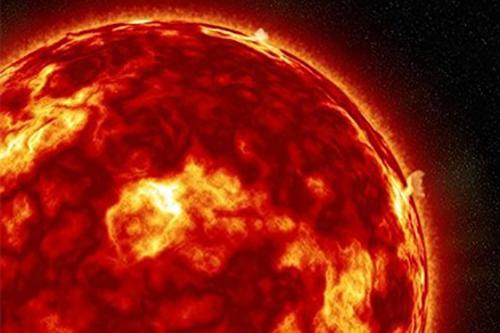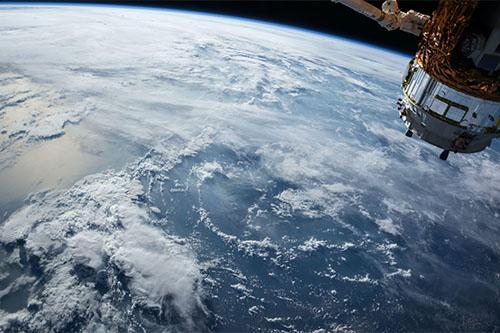“We need to forecast space weather better”
The sun is the most important source of energy for sustaining life on Earth, but it gives us a lot more than just light and heat. It also gives us solar storms.
In 1998 as a PhD student under the supervision of Professor Roger Green, working on image processing and AI for face recognition, Rami Qahwaji took his first steps in the University of Bradford. Now a highly-respected Professor of Visual Computing at the university, Rami has focussed his research across different industries in the fields of satellite/space imaging, remote sensing, digital health and imaging, biometrics, AI and data visualisation.

NASA systems
The Bradford academic has developed intelligent systems in collaboration with NASA, ESA, and the NHS, and has recently written about the need for a better understanding of cosmic weather forecasting.
“Many people still remember the collapse of Canada’s Quebec electrical grid on 13 March 1989, which lasted for nine hours and affected six million people. It caused hundreds of millions of dollars in damages and lost revenues. This blackout was caused by solar storms. The Carrington Event, named for the amateur astronomer who recorded it, was another powerful solar storm which happened in September 1859. Cutting edge technology in 1859 was limited to electrical telegraphs, and most of those failed all over Europe and North America, in some cases giving their operators electric shocks. These days, we’re much more reliant on technology, which is in turn increasingly vulnerable to the effects of space and its unique natural disasters.”
A trained electrical engineer, with an MSc in Control and Computer Engineering, Professor Qahwaji further unpacked his expertise in this area and why the task should continue to be prioritised.
“The sun is the most important source of energy for sustaining life on Earth, but it gives us a lot more than just light and heat. It also gives us solar storms. Disturbances on the Sun, such as coronal mass ejections produced by solar flares that emanate from active sunspot regions, can cause solar storms. Solar flares and coronal mass ejections emit vast quantities of radiation and charged particles into space. These events can damage the Earth’s communication and power infrastructures, resulting in power outages and reduced system functionality. Satellites, space stations and astronauts, aviation, GPS, power grids and more can be affected. As our civilisation becomes more advanced, we become more vulnerable to the effects of solar storms".

Now, as the sun’s activity is on the increase, we need to get better at predicting solar weather.
A 400 year experiment
Humans have been observing and counting sunspots for more than 400 years, arguably making it the longest running experiment in the world. The sun has an 11-year sunspot cycle, and at the moment, our planet is in the middle of that cycle. As we approach the next solar maximum, which is expected to begin in 2025, the Bradford Professor’s work, which has helped predict the likelihood of solar flares, is a great example of innovation that will help our species grapple with vast and complex challenges.
“In space radiation, atoms are accelerated in interstellar space to speeds close to the speed of light. Eventually, the electrons are stripped out and only the positively charged nucleus remains. People are familiar with the northern lights, which is one visible effect of solar radiation. Earth’s magnetic field, which protects us from most of the dangers of space radiation, directs the charged particles to the poles, where they enter our atmosphere and cause beautiful light displays. But the radiation can also impact technology and people. During strong solar radiation storms, energetic protons can damage electronic circuits inside satellites and the biological DNA of astronauts. Passengers and crew flying over the north pole would be exposed to increased radiation. These radiation storms can create errors that make navigation operations extremely difficult. Energetic protons can also ionise the atoms and molecules in the atmosphere, creating a layer of free electrons. This layer can absorb high-frequency radio waves, causing a blackout of high-frequency communications, also known as shortwave radio.”
With our increasing reliance on technology, research shows that predicting the weather in space is crucial. However, accurately predicting space weather has long been a challenging problem for experts. To tackle the problem, Rami worked in a specialist team to pioneer new techniques for automatic processing, detection and feature extraction of solar features – like active regions and sunspots – captured by Nasa’s solar dynamics observatory satellite.
"My colleagues and I developed a real-time automated computer system which uses image processing and artificial intelligence technologies to monitor and analyse solar satellite data. This helps predict the likelihood of solar flares in the coming 24 hours" says Rami.

The team pioneered new techniques for automatic processing, detection and feature extraction of solar features – like active regions and sunspots – captured by Nasa’s solar dynamics observatory satellite, and also introduced the first automated and real-time system to classify sunspots. Before this, the classification of sunspots was a manual process painstakingly carried out by experts.
"Our space weather prediction system is publicly available and fully integrated with NASA's Community Coordinated Modeling Center (CCMC) Portal. It is now used as one of the decision-making tools for Nasa’s robotic missions and to manage radiation effects on Nasa’s Chandra X-ray observatory orbit".
"As we continue venturing further into space, we’ll need to strengthen our current space weather prediction capabilities to build a greater picture of solar activity and mitigate its effects around the solar system".
The challenge
"Space missions and astronauts are much more likely to be affected by radiation, because they aren’t protected by Earth’s magnetic field. The effects on humans could include radiation sickness, increased risk for cancer, degenerative diseases and central nervous system effects. Despite these risks, human and robotic activities are increasing in space and Nasa is working to land humans on Mars by the 2030s. There are two rovers – Curiosity and Perseverance – and one lander currently operational on Mars, with another rover planned for launch in 2022.
Our space weather prediction system is publicly available and is now used as one of the decision-making tools for Nasa’s robotic missions and to manage radiation effects on Nasa’s Chandra X-ray observatory orbit.
Professor Qahwaji admits that the task ahead is incredibly challenging, as most solar observations are taken from Earth’s field of view. However, from Rami’s research and innovation efforts, it is clear that better modelling and investigation of the evolution of solar features is necessary to accommodate for the drastically different celestial orbits around the Sun.
